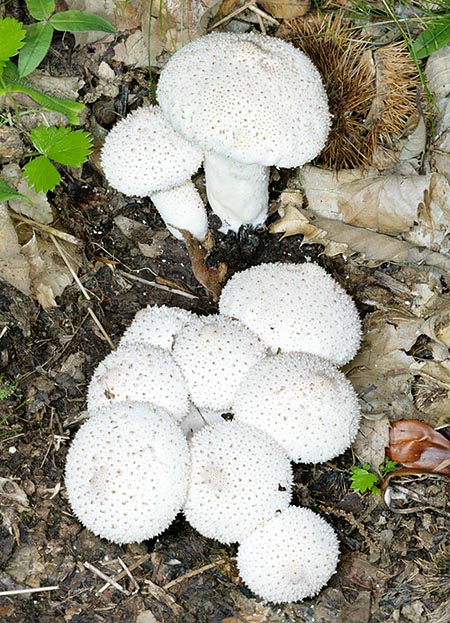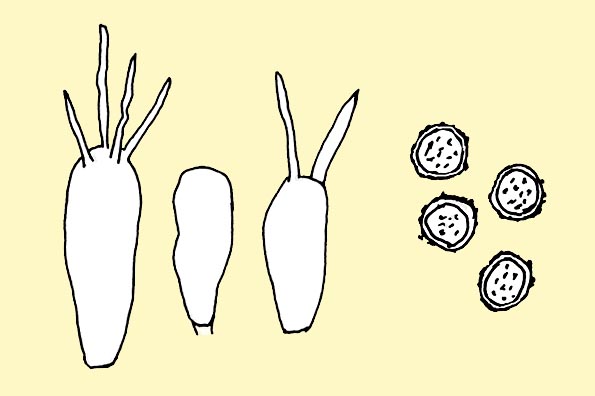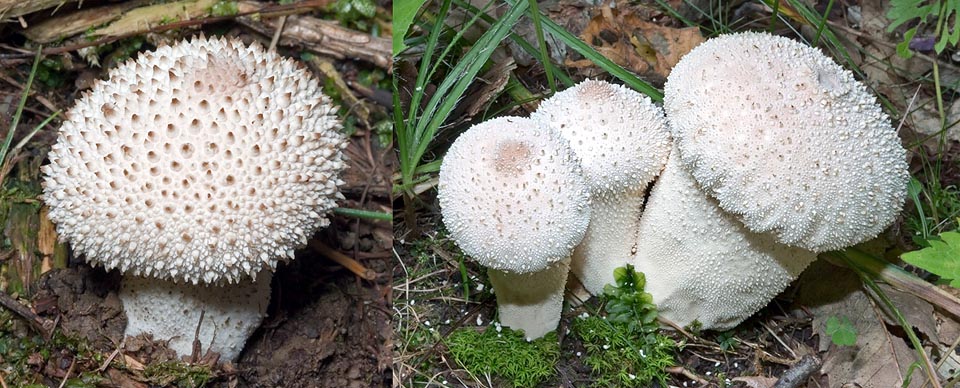
Text © Livio Agostinelli

English translation by Mario Beltramini

Terricolous, ubiquitary Lycoperdon perlatum is common in the woods © Mazza
Family: Lycoperdaceae Chevallier, 1826.
Genus: Lycoperdon Persoon, 1801.
Lycoperdon perlatum Persoon : Persoon, 1801
The etymology of the genus Lycoperdon comes from the Greek “lúkos” = wolf, and “pérdomai” = I emit air from the bowels. Wolf fart.
The name of the species comes from the Latin “perlate”, which means very ample, much enlarged, referred to the warts covering a space which is, rightly, much wide, much ample.
It’s a fairly common species, known in Italy with the popular names of “vescia”, “loffa”, “puzzola”, “vescia gemmata”; in France, “Vesse de loup perlée”; in Spain, “ Pet de llop perlat”, “pedo de lobo”, “cuesco de lobo”, “bejín perlado”; in the English speaking countries, “common puffball”, Devil’s snuffbox, “warted puffball”, “gem-studded puffball”; in Germany, “Flaschenstäubling”, “Flaschenbovist” “Flaschen-Stäubling”.
Description of the genus
To the genus Lycoperdon are ascribed carpophores typically pyriform, or subglobose, pseudo-stipitate or turbinate. The carpophores fit into the substrate with the fascicular mycelial hyphae or with cords of rhizomes.
The carpophores of this genus have the exoperidium initially united, then dissociated in granules, pearls, warts or spines, which, initially thick, transform then due to the growth; once their protecting function is ended, they dry up and dissolve, and also the exoperidium dissolves partially or totally.
The endoperidium is thin, membranous, with filamentous hyphae, smooth, opaque, elastic, of soft consistency; it is physically tied to the fascicle of the mycelial hyphae of the base. The release of the spores takes place through the opening of the orifice in the endoperidium at the apex. The gleba, initially white and firm, while ripening becomes dry and dusty and includes the spores and the capillitium; the subgleba is well developed, with small cells structure visible to the naked eye, the diaphragm is either present or absent.
Description of the species

Basidia and spores of Lycoperdon perlatum © Pierluigi Angeli
Basidiocarp: in shape of overturned pear, subglobose, resembling to a pestle, with whitish colours, then cream and finally with brown shades. The outer part, the exoperidium, is formed by cone-shaped and truncated spines easily rubbed off, surrounded by small warts. When the spines, with the ripening or with the time, fall down, the exoperidium remains decorated by a typical reticulated pattern. The endoperidium is smooth, membranous, thin, opaque, elastic and soft with the humidity, from cream to ochre-grey colour.
Gleba: (the fleshy inner part): initially white and firm, then becoming, when ripe, olive-yellowish, brown and converting to dust formed by spores and capillitium. The dispersal of the spores happens though the opening of a small hole at the apex of the carpophore (apical dehiscence). The well-developed subgleba forms the whole pseudo-stem and is formed by well visible small cells.
Habitat: mainly terricolous, ubiquitous in conifer forests as well as in broadleaf ones.
Edibility: It may be eaten, provided the gleba is candid white.
Microscopy: 3,5-4,5 µm, globose and warty spores, some with the sterigma still attached. Exoperidium of pseudo-parenchymatic structure with rounded or strongly ellipsoidal spherocysts and with thin wall.

Edible when young, is covered by spines which later fall replaced by a reticulum. The cream white colour darkens with age © Giuseppe Mazza
Remarks: It’s by sure the most diffused puffball (common name), its sporophores are recognizable due to the pear-like shape and the particular structure of the exoperidium formed by conical spines easily detachable and surrounded by a line of small warts. It may be mistaken only with Lycoperdon pyryforme Schaeffer : Persoon, but this grows on decaying wood which, when the spines fall, does not show the reticulum.
Synonyms: Lycoperdon gemmatum Batsch 1783; Lycoperdon gemmatum var. perlatum Persoon 1829.
→ For general notions about Fungi please click here.
→ To appreciate the biodiversity of MUSHROOMS please click here.
